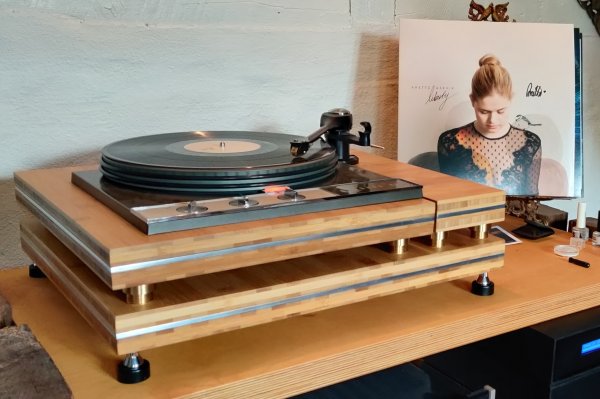Since I think I may be the original instigator here - Remdeck and Peter had asked some questions in my OP "Blond on blonde... On blonde" thread here:
https://www.whatsbestforum.com/threads/blonde-on-blonde-on-blonde.30295/
From my experiences in building plinths, a constrained layer approach has worked best for me by far. When I first acquired a Garrard, I tried a stacked birch ply plinth. It was cheap, easy to build and it seemed to be what a lot of people were using at the time (Art Dudley are you out there?)... It worked okay and I loved the sound of this new turntable, in comparison to the VPI Aries I had at the time.
I am a guitar player and something made me start to wonder about using tone woods in a plinth - what works well for a musical instrument seems like it should also work for a plinth, right? I had been reading about the Shindo Garrard and also the plinths from ____ . My next plinth was made from two layers of 2-inch hard maple, with the grain running opposite in each layer - four inches total. If you happen to play guitar (or another instrument that uses maple - mandolin, violin, etc.) you'll know that maple is less warm, more linear, and has a "crisper", more extended top end; as apposed to something like Mahogany which is, generally speaking, warmer sounding. Long story short; the birch ply plinth ended up in the fire pit at a backyard party.
Since this, I have experimented with other tone woods - cherry, ebony, mahogany, and Engleman Spruce. They all sound different and I like them all for different reasons/applications. My experience suggests always using hardwood as apposed to softer woods like pine, soft maple, etc.
At some point I heard about Panzerholz and thought I would try that. I have since found that I really like using it as long as it's "layered" with other materials. In my Technics SP10 Mk.3 plinth I use it more extensively than in my Garrard plinths, because I want the Garrard to be a bit less damped. I also used a 1 inch plate of a aluminum in the SP10.
For the most part, I have built my plinths with a detached/seperate arm pod. I tried to make these arm pods as inert and damped as possible and they are almost 100% panzerholz on the inside. They are capped with either ebony or hard maple.
In my most recent plinth build I incorporated a layer of 2-inch bamboo - I was able to find a really large and thick bamboo cutting board on Amazon. I'm still tuning this 'table but so far I think the bamboo is a winner.
I have also started to experiment more with soapstone. It has some very interesting acoustic properties - much different than slate for instance.
Lot's more I can share and I will also try to post some pics later if anyone is interested.




